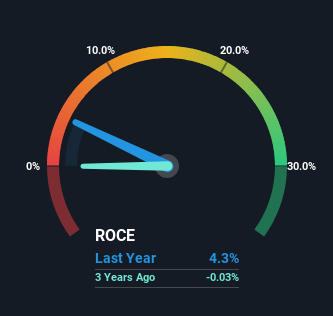- Japan
- /
- Transportation
- /
- TSE:9042
Here's What's Concerning About Hankyu Hanshin Holdings' (TSE:9042) Returns On Capital

When researching a stock for investment, what can tell us that the company is in decline? Businesses in decline often have two underlying trends, firstly, a declining return on capital employed (ROCE) and a declining base of capital employed. Trends like this ultimately mean the business is reducing its investments and also earning less on what it has invested. So after glancing at the trends within Hankyu Hanshin Holdings (TSE:9042), we weren't too hopeful.
Understanding Return On Capital Employed (ROCE)
For those that aren't sure what ROCE is, it measures the amount of pre-tax profits a company can generate from the capital employed in its business. Analysts use this formula to calculate it for Hankyu Hanshin Holdings:
Return on Capital Employed = Earnings Before Interest and Tax (EBIT) ÷ (Total Assets - Current Liabilities)
0.043 = JP¥105b ÷ (JP¥3.0t - JP¥511b) (Based on the trailing twelve months to December 2023).
So, Hankyu Hanshin Holdings has an ROCE of 4.3%. In absolute terms, that's a low return but it's around the Transportation industry average of 4.6%.
View our latest analysis for Hankyu Hanshin Holdings

In the above chart we have measured Hankyu Hanshin Holdings' prior ROCE against its prior performance, but the future is arguably more important. If you're interested, you can view the analysts predictions in our free analyst report for Hankyu Hanshin Holdings .
What Does the ROCE Trend For Hankyu Hanshin Holdings Tell Us?
There is reason to be cautious about Hankyu Hanshin Holdings, given the returns are trending downwards. Unfortunately the returns on capital have diminished from the 5.5% that they were earning five years ago. And on the capital employed front, the business is utilizing roughly the same amount of capital as it was back then. This combination can be indicative of a mature business that still has areas to deploy capital, but the returns received aren't as high due potentially to new competition or smaller margins. If these trends continue, we wouldn't expect Hankyu Hanshin Holdings to turn into a multi-bagger.
The Bottom Line
All in all, the lower returns from the same amount of capital employed aren't exactly signs of a compounding machine. In spite of that, the stock has delivered a 13% return to shareholders who held over the last five years. Regardless, we don't like the trends as they are and if they persist, we think you might find better investments elsewhere.
If you'd like to know about the risks facing Hankyu Hanshin Holdings, we've discovered 1 warning sign that you should be aware of.
While Hankyu Hanshin Holdings isn't earning the highest return, check out this free list of companies that are earning high returns on equity with solid balance sheets.
Valuation is complex, but we're here to simplify it.
Discover if Hankyu Hanshin Holdings might be undervalued or overvalued with our detailed analysis, featuring fair value estimates, potential risks, dividends, insider trades, and its financial condition.
Access Free AnalysisHave feedback on this article? Concerned about the content? Get in touch with us directly. Alternatively, email editorial-team (at) simplywallst.com.
This article by Simply Wall St is general in nature. We provide commentary based on historical data and analyst forecasts only using an unbiased methodology and our articles are not intended to be financial advice. It does not constitute a recommendation to buy or sell any stock, and does not take account of your objectives, or your financial situation. We aim to bring you long-term focused analysis driven by fundamental data. Note that our analysis may not factor in the latest price-sensitive company announcements or qualitative material. Simply Wall St has no position in any stocks mentioned.
About TSE:9042
Hankyu Hanshin Holdings
Operates in the urban transportation, real estate, entertainment, information and communication technology, travel, and international transportation businesses in Japan and internationally.
Second-rate dividend payer and slightly overvalued.
Market Insights
Community Narratives



